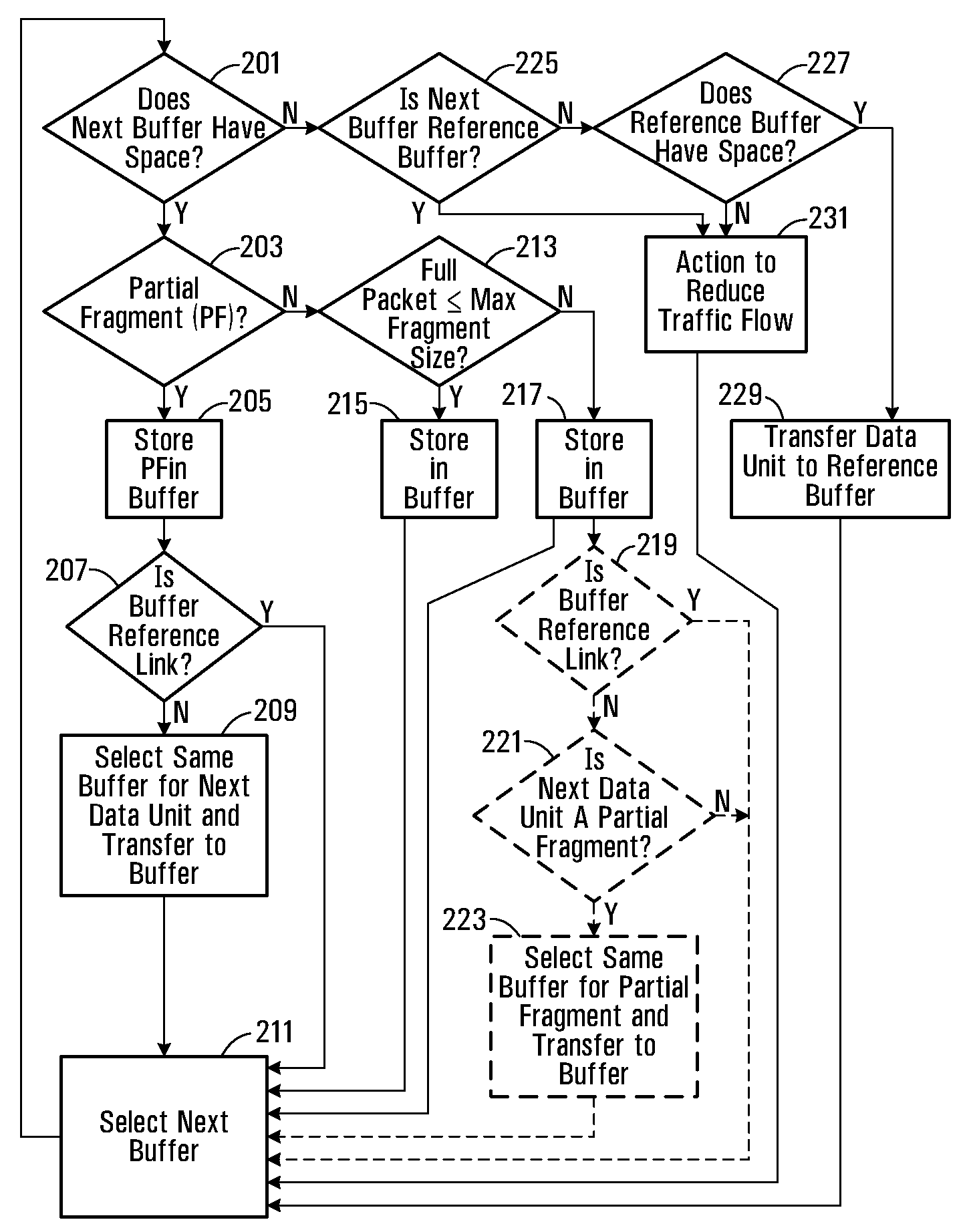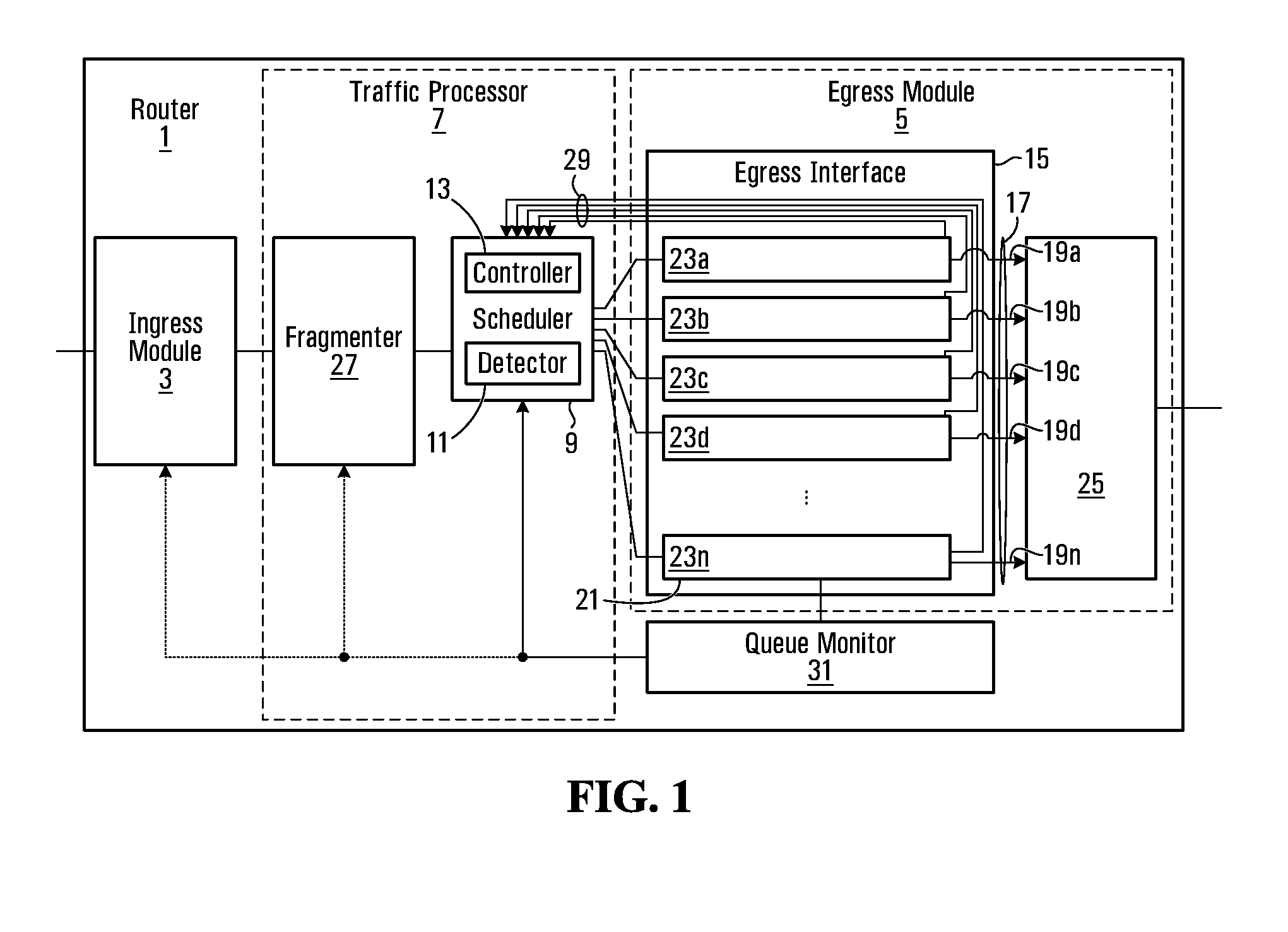[0009]In this arrangement, the controller for managing the distribution of data units to the links of a multi-
link group is sensitive to the data unit, and this enables the controller to distribute data units to the links more evenly. In particular, the controller is sensitive to a characteristic of the data units that may vary between data units, such as the size of the data unit. This allows the controller to discriminate between differently sized data units and control their distribution to links of a multi-link group on that basis.
[0010]When transmitting
variable size packet fragments onto a multi-link PPP (point-to-point protocol) or FR (
frame relay) interface on a switch or router, the inventors have found that it is desirable to distribute traffic evenly to all member links. The even distribution of traffic minimizes transmission and reassembly latency. On a highly
channelized multi-service switch / router, the challenge is to distribute packets evenly to all member links of a bundle without impacting the
throughput on other channels. This requires a highly
efficient algorithm when selecting a member link onto which to transmit.
[0011]In some embodiments, the controller is operative to consecutively select the same link a plurality of times wherein each selection results in the transfer of a data unit to the link, if at least one of the data units has a size below a predetermined value. This mechanism enables, in addition to a relatively
small data unit, another data unit to be transferred to the same link before selecting another link, thereby preventing only a relatively
small data unit to be transferred to a link in a single transfer session. This results in a more even distribution of traffic between the links of the multi-link group, and reduces the likelihood of a
queue or link running dry.
[0012]In some embodiments, the apparatus further comprises a
detector for detecting another characteristic of a data unit, and the controller is operative to select the link to which to transfer the data unit based on the detected characteristic. Thus, in this embodiment, the controller additionally selects the link based on whether a particular characteristic is present in a data unit. For example, the characteristic may be whether or not the data unit is a fragment of a packet. In one embodiment, if it is determined that the data unit is not a fragment of a packet and is below a predetermined
fragment size (and is therefore an integral packet), the controller may be operative only to transfer that packet to the currently selected link without including another data unit which would otherwise increase the amount of traffic transferred to that link in a single transfer session. For example, this mechanism allows
full data packets below a predetermined size such as voice packets, for instance, to be distributed among different links rather than two or more packets of such size being transmitted successively on the same link. This also provides a mechanism which allows the controller to discriminate between a full packet below a maximum
fragment size and a fragment of a packet below the
maximum size so that, for a plurality of consecutive full packets below the maximum
fragment size, different member links can be successively selected for the transfer of each packet. This allows a contiguous
stream of sub-maximum fragment size packets to be evenly distributed between the links and not all transmitted on a single link, so that the efficiency benefits of the multi-link
system can be obtained.
[0016]In this arrangement, the reference link is used not only as a data unit overflow but may also be selected by the controller for transmitting data units when not being used for data overflow. The controller may also use a different criteria for transferring data units to the reference link to that used for transferring data to one or more other links. For example, the criteria used by the controller may have the effect that when the reference link is selected for transfer of non-overflow data, less traffic tends to be transferred to the reference link than to at least one other member link. In this arrangement, the controller is operative to bias selection of the links to which to transfer data units, towards one or more other member links relative to the reference link. In one specific, non-limiting example, when a data unit to be transferred to the reference link comprises a partial fragment of a packet (i.e. a fragment below a predetermined maximum fragment size), the controller may transfer only that fragment to the reference link without an additional data unit before selecting the next potential link to which to transfer the next data unit or units. This implementation provides a mechanism for reducing the non-overflow traffic on the reference link relative to traffic on the other member link(s). Thus, in contrast to the conventional round robin distribution mechanism discussed above which tends to under fill member links other than the reference link, the present embodiment better fills the member links while moderating the amount of traffic on the reference link so that better use is made of the multi-link
system as a whole.
[0017]In some embodiments, a monitor is provided to monitor a status indicative of the amount of traffic and / or the amount of available space in a reference buffer of the reference link and to generate a
signal indicative of the status which is used to control the flow of communication traffic to be distributed to the buffers and links of the multi-link group. In some embodiments, only the status
signal of the reference buffer is used to control the flow of incoming communication traffic for distribution to the buffers and links of the multi-link group. This arrangement simplifies the system and reduces the resources (e.g. hardware) required to implement this function. In other embodiments, more than one reference link may be provided for a multi-link group, where the number of reference links is less than the total number of member links of the group. In such an arrangement, the status of each, or fewer than each reference buffer may be monitored, and their status used to control the flow of traffic for distribution by the multi-link group.
 Login to View More
Login to View More  Login to View More
Login to View More 


